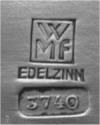W.M.F. Württembergische Metallwaren Fabrik
The Wurtemberg Electro Plate Company was founded in the year 1853 with 16 workers.
Daniel Straub the owner was born on the first of July 1815 in the ‘Schimmelmühle’in Geislingen
He was very interested in mechanical engineering .His first attempt was at the machinery of the family mill .
He married the miller's daughter of the ‘Kapellmühle’,and became the owner. He was very successful at an early age.
In 1847 ,when the Stüttgart to Ulm railway was under construction , Straub was able to invest in the Geislingen to Ulm section and began also
a workshop for the repair and construction for the railway .His company was named
‘Daniel Straub, mechanische Werkstatte fur Müllbau und Turbinen’
Straub’s next step was to enter into partnership with the two brothers Friedrich & Louis Schweizer as manufacturers of metal goods .The new firm was called Straub & Schweizer.
At that time the industrial revolution in Wurtemberg took big steps forward thanks to the railway and the many factories that opened their doors.
In the London 1851 “ Exhibition of the Work of industry of all Nations” 109 exhibitors from Wurtemberg , showed their products for the first time .
By 1856 the new firm Straub & Schweizer employed 60 people and was producing
kettles , candelabra ,& carriage lamps in particular as well as all kinds of household articles.
They were made of copper or bronze or by the ‘close-plating’ process invented in 1742 by Thomas Bolsover in Sheffield and introduced to Germany in 1810 by Carl Deffner in Esslingen. In 1862 they won a prize medal at the International Exhibition in London .
They became very famous with their products and all became prosperous. They now had 120 workers in 1866 .After 1870 the firm was called Straub& Söhn and they worked hard to improve the silver plating of their work .
A firm called ‘A Ritter & co, Versilberungsanstalt in Stuttgart moved to Esslingen in 1871 and within a short space of time their new goods became extremely popular. By 1880 A Ritter & Co employed 250 workmen and was successful on both national and international levels.
They won several prizes in exhibitions in Vienna (1873) Munich (1876) Philadelphia U.S.A (1876) to name a few.
On 23rd June 1880 the two firms merged into one big firm ‘The Württembergische Metallwarenfabrik, Geislingen-Steige .From the very beginning , the company’s trademark was an Ostrich (in German strauss) ,the heraldic animal of the Straub family .
In 1881 Daniel Straub retired as director and the new manager became Carl Haegele.
A glassworks was added to the factory to provide the glass liners and other cut and engraved glass components for the electro -plated articles.
In 1886 WMF took over the Plewkiewetz & Co factory in Warsaw (Poland)
Around 1900,WMF opened several shops in Germany and had 3500 workers.
In 1900 they acquired Albert Köhler u. Cie in Vienna (Austria) that produced the WMF items under the mark AK & Cie.
The period between 1900 and 1914 was one of further expansion for the company
In 1905 WMF acquired the ORIVIT AG an important Cologne company known for its Jugendstil pewter, followed a year later by the purchase of the ORION Kunstgewerbliche Metallwarenfabrik ( Art Metalware Factory) . WMF came into the possession of the largest example of the ‘Huber Press’ that had been constructed (52,000lbs to the square inch)
After 1914 the firm had lost all its export markets and produced fewer products but overcame the bad times . Hugo Debach, the managing director from 1927 onwards ,was able to restore the company to its position as a major world producer of utilitarian and artistic glass and metal ware.
StatCounter - Free Web Tracker and Counter




Items in our collection

date : 1900 /1906
not marked but 100% WMF
Ø : 15.3 inch / 39 cm

date : 1906
marked :ostrich WMF g in a bee-hive and number 174
height : 4.0 inch /10 cm

date : 1904
marked : Ostrich in square
Ø 17.0 inch / 43.5 cm

date : 1904
marked : Ostrich in square
Ø 17.0 inch / 43.5 cm

date : 1904
not marked
Height : 8.5 inch / 21.0 cm

date : 1900
Designer : Alexandre Charpentier (1856–1909)
Famous for his relief’s of womans
marked : WMF and designers mark AC
width : 10.0 inch / 25.0 cm

date : 1900/ 1906
marked : ostrich WMF g in a beehive
height : 2.2 inch /5.5 cm
